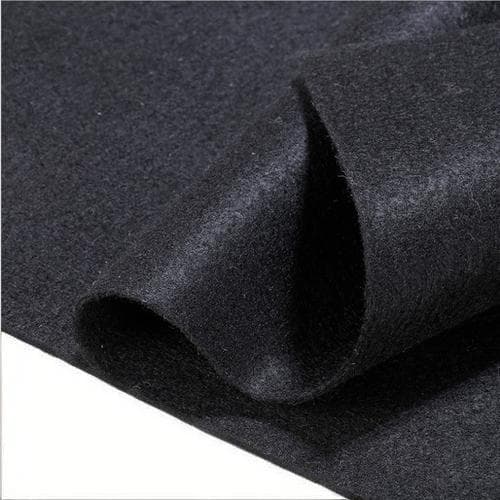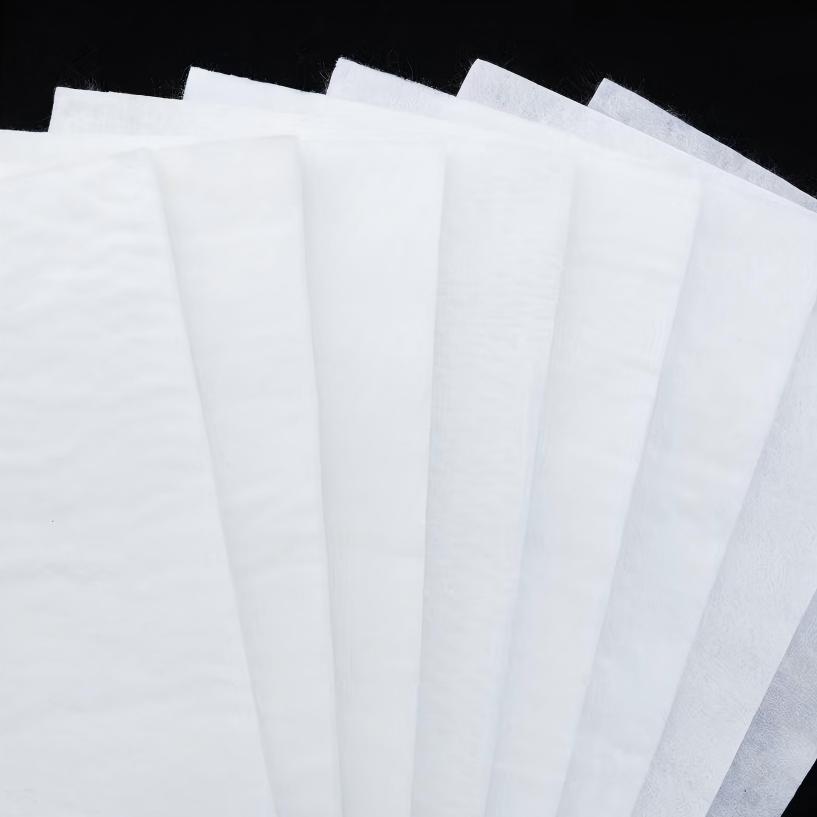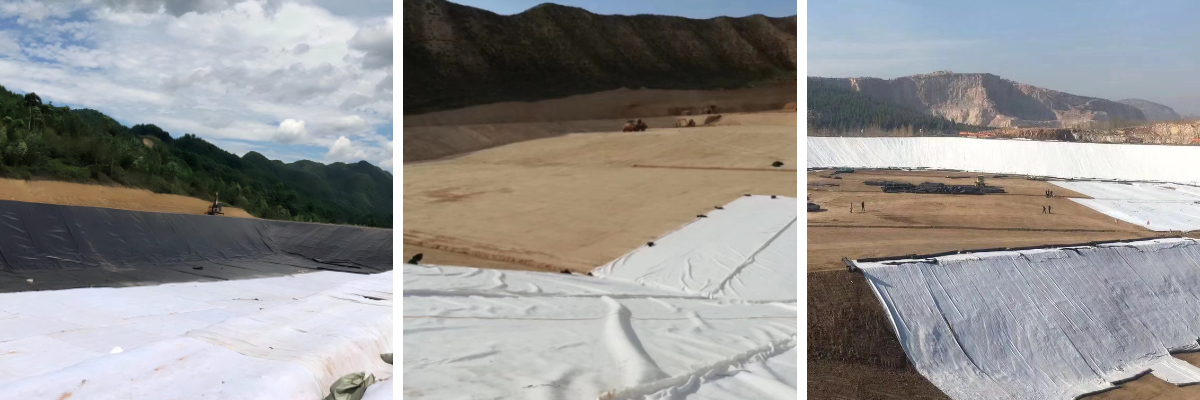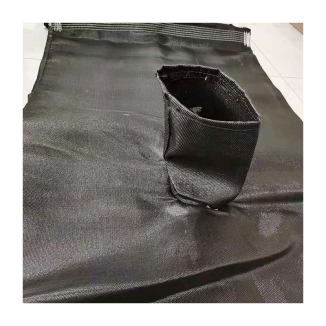Filter Drain Geotextile
1. Strong integrity: As a continuous whole material, it can evenly distribute loads and reduce uneven settlement.
2. Ensure project quality: Its performance is stable, specifications are uniform, and it can provide long-term and reliable functional guarantees.
3. Shorten the construction period: The laying is simple and fast, less affected by weather, and can effectively accelerate the project progress.
4. Reduce engineering costs: It can usually replace a large amount of traditional materials such as sand, stone, and concrete, saving material and transportation costs, while reducing the footprint and overall cost.
5. Environmental protection: It can effectively prevent soil erosion and play a role in protecting the environment in ecological restoration and landfill projects.
Product Introduction:
Filter Drain Geotextile is a new type of composite material in geotechnical engineering, made from high molecular weight polymers (such as polypropylene, polyester, polyethylene, etc.) through processes such as spinning, needle punching, thermal bonding, or chemical bonding. It has multiple functions such as filtration, drainage, isolation, reinforcement, and protection, and is widely used in civil engineering, water conservancy, transportation, environmental protection, and other engineering fields. It is one of the indispensable key materials in modern geotechnical engineering.
Core definition
From the perspective of material properties and engineering functions, the definition of geotextile can be accurately interpreted from two dimensions:
Material dimension: A flexible sheet material with a certain thickness, porosity, and mechanical properties formed by physical or chemical processing using synthetic fibers (or natural fibers such as flax and coconut shell fibers, but currently the mainstream is synthetic fibers) as the substrate. Unlike traditional cotton and linen fabrics, its weather resistance and corrosion resistance are more suitable for engineering environments.
Functional dimension: In geotechnical engineering, functional materials are used to solve the problem of "water soil structure" interaction. Their core function is to coordinate the deformation of soil and structures, control water migration, and enhance soil stability, rather than for decorative or general protective purposes.
Main Features
The characteristics of geotextile are determined by its raw material properties and processing technology, and the core can be summarized as "four resistances, one flexibility, and one controllability", as follows:
Strong weather resistance: Synthetic fiber substrates (such as polypropylene) can resist ultraviolet radiation, alternating high and low temperatures (stable performance under -40 ℃~80 ℃ environment), and are not easily aged or brittle when exposed or buried for long-term use. The service life can reach 10~50 years (depending on the material grade difference).
Excellent corrosion resistance: no obvious reaction to acid and alkali solutions (within the range of pH 3~11), salt mist, microorganisms (such as bacteria and fungi in soil), and no corrosion degradation. It is suitable for harsh environments such as coastal mudflat, saline alkali land, sewage treatment plant, etc.
Good wear resistance: The surface fiber structure is tight and has high toughness. When in contact with soil, sand, and construction machinery, it can withstand friction and compression without being easily damaged, meeting the mechanical friction requirements of engineering construction and long-term use.
Flexible and deformable: The material is soft and can expand and contract synchronously with small deformations of the soil (such as settlement and expansion), without breaking due to soil displacement, especially suitable for easily deformable scenarios such as soft soil foundations and slopes.
Controllable porosity: By adjusting processing techniques such as needle density and textile yarn thickness, the porosity can be controlled between 30% and 90%, ensuring smooth water infiltration (drainage/filtration) and preventing soil particle loss (isolation), achieving precise functionality of "permeable but impermeable".
Product Parameters:
project | metric | ||||||||||
Nominal strength/(kN/m) | |||||||||||
6 | 9 | 12 | 18 | 24 | 30 | 36 | 48 | 54 | |||
1 | Longitudinal and transverse tensile strength / (kN/m) ≥ | 6 | 9 | 12 | 18 | 24 | 30 | 36 | 48 | 54 | |
2 | Maximum elongation at maximum load in longitudinal and transverse directions/% | 30~80 | |||||||||
3 | CBR top penetration strength /kN ≥ | 0.9 | 1.6 | 1.9 | 2.9 | 3.9 | 5.3 | 6.4 | 7.9 | 8.5 | |
4 | Longitudinal and transverse tearing strength /kN | 0.15 | 0.22 | 0.29 | 0.43 | 0.57 | 0.71 | 0.83 | 1.1 | 1.25 | |
5 | Equivalent aperture O.90(O95)/mm | 0.05~0.30 | |||||||||
6 | Vertical permeability coefficient/(cm/s) | K× (10-¹~10-), where K=1.0~9.9 | |||||||||
7 | Width deviation rate /% ≥ | -0.5 | |||||||||
8 | Unit area mass deviation rate /% ≥ | -5 | |||||||||
9 | Thickness deviation rate /% ≥ | -10 | |||||||||
10 | Thickness coefficient of variation (CV)/% ≤ | 10 | |||||||||
11 | Dynamic perforation | Puncture hole diameter/mm ≤ | 37 | 33 | 27 | 20 | 17 | 14 | 11 | 9 | 7 |
12 | Longitudinal and transverse fracture strength (grab method)/kN ≥ | 0.3 | 0.5 | 0.7 | 1.1 | 1.4 | 1.9 | 2.4 | 3 | 3.5 | |
13 | Ultraviolet resistance (Xenon arc lamp method) | Longitudinal and transverse strength retention rate% ≥ | 70 | ||||||||
14 | Ultraviolet resistance (fluorescence UV lamp method) | Longitudinal and transverse strength retention rate% ≥ | 80 | ||||||||
Product Applications:
1. Water conservancy engineering: the core solution to the problem of "moisture control"
River/reservoir anti-seepage: used in combination with geomembrane, laid on the inside of the dam to prevent reservoir water from seeping into the soil and causing dam piping;
River bank/channel protection: laid on the slope of the river bank to prevent soil loss caused by water flow erosion, while allowing groundwater seepage to prevent slope collapse due to water accumulation;
Wastewater treatment plant: used as a filter layer for sedimentation tanks and filtration tanks, blocking sludge particles and allowing clean water to pass through, achieving solid-liquid separation.
2. Transportation Engineering: The Core Solution to the Problem of "Roadbed Stability"
Highway/railway subgrade: laid at the base of the roadbed (between the soil foundation and the sand and gravel base), separating the soil foundation from the sand and gravel to prevent soil particles from infiltrating the sand and gravel and causing blockage of the base. At the same time, the accumulated water in the roadbed is drained to avoid softening and settlement of the roadbed;
Backfilling of bridge abutment: laid at the junction of bridge abutment and subgrade to reduce differential settlement between abutment backfill and subgrade, and avoid "bridge head jumping" on the road surface;
Tunnel engineering: laid on the outer side of the tunnel lining as a drainage layer, collecting groundwater around the tunnel and discharging it through blind ditches to prevent lining seepage.
3. Municipal Engineering: Core Solution to "Space Utilization and Environmental Protection" Issues
Underground parking lot/comprehensive pipe gallery: laid between the structural layer and the soil, isolating soil particles and draining accumulated water around the structural layer to prevent structural cracking;
Landfill site: As the "anti-seepage filtration" system of the landfill site, the lower layer is combined with HDPE geomembrane to prevent leachate from polluting groundwater, and the upper layer filters impurities in the leachate to avoid blind ditch blockage;
Artificial lake/landscape water system: laid between the soil at the bottom of the lake and the waterproof layer, isolating the soil and preventing the waterproof layer from being pierced by sharp stones.
4. Environmental Protection and Ecological Engineering: Core Solution to "Ecological Protection" Issues
Slope ecological restoration: used in conjunction with vegetation nets and nutrient soil, laid on exposed slopes to fix soil and nutrient soil, prevent rainwater erosion, and allow plant roots to penetrate and grow, achieving a combination of "engineering protection+ecological greening";
Soil and Water Conservation: Laying in sloping farmland and reclaimed mining areas to reduce soil erosion and protect surface soil fertility;
Wetland restoration: used in wetland water level regulation areas to filter sediment and pollutants in water, providing a clean growth environment for aquatic organisms.
5. Construction engineering: core solution to the problem of "foundation stability"
Soft soil foundation treatment: Lay reinforced geotextile on the surface of the soft soil foundation, then fill and compact the soil layer by layer. The tension of the geotextile disperses the soil pressure, accelerates the consolidation of the soft soil, and improves the bearing capacity of the foundation;
Basement waterproofing: Installed between the basement floor and the soil as a drainage layer, it collects groundwater from the soil and discharges it through drainage boards to prevent basement seepage.
In summary, geotextile has become a standardized material for solving geotechnical problems in modern engineering construction due to its multifunctional, high-efficiency, and low-cost advantages. Its application scope is still expanding to emerging fields such as ecological restoration and marine engineering, promoting the development of engineering construction towards a more environmentally friendly and efficient direction.












